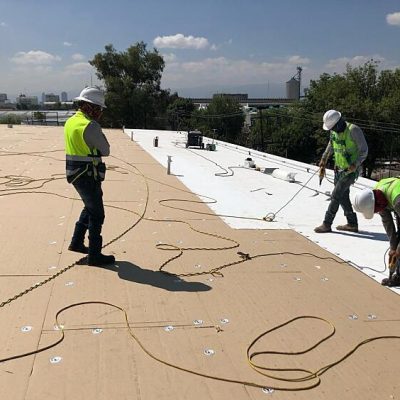Commercial Membrane Systems
Dozens of solutions for commercial and industrial buildings.
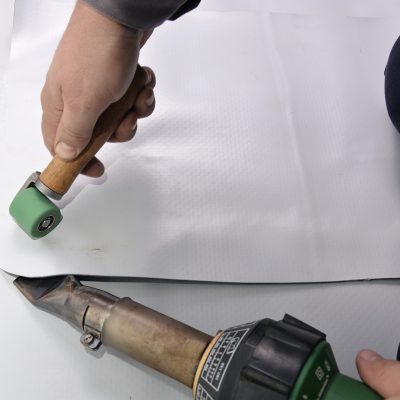
Membrane roofing systems are installed on warehouses, departments stores, factories and some homes in certain areas of the US. These are often called “low-slope” or “flat roofing” systems, and must be built with full consideration of how to evacuate precipitation effectively.
More so than other roof systems, membrane systems require significant design and planning, as well as proper installation to avoid pooling water and chemical buildup.
Unlike sloped systems where airflow exists beneath the roof, such as in attics, flat roofs are most commonly insulated immediately below the roof covering. The exposed roof covering is also colored or coated to reflect the maximum amount of UV radiation. This provides an opportunity to focus solely on thermal efficiency without worrying about the aesthetics of a highly reflective but bland-looking roof.
Most systems installed today are single-ply systems. They can be installed over new insulation after the old covering and insulation are removed, or using specific materials to be applied over an old roof system.
Peace of mind
Our GAF EverGuard systems come with varying warranties based upon style and thickness.
Membrane Systems
The best solution for you will be determined by traffic, manufacturing exhaust and energy efficiency.
TPO Membrane
Thermoplastic Polyolefin, more commonly referred to as TPO, was developed in the 1970s. This roof membrane is known for being flexible and weldable with no plasticizers.
What to keep in mind about TPO:
- TPO has excellent weathering characteristics and strong tear and break resistance.
- Because TPO is typically white, it can also improve energy efficiency by reflecting heat away from the roof to keep it cooler.
- TPO offers multiple installation options including adhered, mechanically attached, and in some cases, ballasted.
- Not all TPO is the same. Manufacturing differences can result in varying performance. While the basic TPO polymer is generally the same across membranes, stabilizers and other ingredients may vary.
- TPO seams are heat-welded together making the system watertight. This is an important difference when compared to EPDM, which has seams that are glued.
- TPO has the largest market share of all single-ply membranes.
PVC Membrane
Polyvinyl Chloride (PVC) roof membrane is a reliable, versatile membrane that offers the flexibility of TPO with the added benefit of increased protection against chemicals. PVC is created from a hard solid that is made flexible with the addition of liquid plasticizers.
What to keep in mind about PVC:
- Same material as pool liner. If it can hold thousands of gallons of water in a basin, it can hold a lifetime of rain out.
- PVC offers slightly more flexibility than TPO, making it easier to handle and install.
- It has better chemical resistance than other single-ply roofing membranes, so it can withstand exposure to oils and greases longer than other membrane types. This makes it a preferred roof membrane type for restaurants and food manufacturing facilities. While PVC does have good chemical resistance, manufacturer’s guarantees and warranties typically exclude from coverage damage caused by chemical exposure.
- Just as with TPO, PVC seams are heat-welded together making the system watertight. This is an important difference when compared to EPDM, which has seams that are glued.
- PVC is available in reflective colors to improve energy efficiency by reflecting heat away from the roof to keep it cooler.
- PVC offers slightly less tear and breaking strength than TPO.
EPDM Membrane
Ethylene propylene diene terpolymer is known in the roofing industry as EPDM and referred to by many as rubber roofing. It is manufactured using derivatives of oil and natural gas and is available in both black and white.
What to keep in mind about EPDM:
- EPDM is a durable rubber membrane that has been performing well on low-slope roofs for many years in a wide variety of climates.
- An EPDM system offers contractors multiple installation options, including ballasted, mechanically attached, or adhered.
- If the membrane is exposed to chemicals or greases on the rooftop, it may degrade and become more susceptible to damage or punctures.
Investing big in your company?
Reflective membrane roofing can reduce up to 80% of your structure’s solar head absorption.
Insulate your most important assets
People and even electronics can’t do their best when the heat is cranked up.
PolyISO Insulation
Somewhere between your roof covering and your interior ceiling, your property must have a properly rated fire-resistant thermal barrier. The simplest and most cost effective solution is in the form of hardened insulation immediately below your roof membrane, called Polyiso (polly-eye-so).
Polyiso has become the go-to insulation for commercial roofing with about 75% market share. The reasons include:
- Lowest cost per R-value.
- High R-value per inch, meaning it doesn’t require as much thickness as other types of rigid insulation to achieve the same insulation performance.
- Good fire resistance. Being a thermoset unlike polystyrene foams, it doesn’t melt during a fire. Melting of thermoplastic foams and subsequent flowing down of molten material through the deck into a building can be hazardous for occupants and fire crews.
- Solvent compatibility adhesives used in adhered systems don’t adversely affect polyiso. This is not the case with polystyrene foams.
- Reduced condensation when installed correctly in a properly designed system, polyiso helps to resist interior air from reaching the underside of the membrane, thereby reducing condensation risks.
Electricity is four times as expensive as gas, on an equivalent Btu basis. Therefore, polyiso’s greatest value is seen during summer months when air conditioning usage is at its highest. A roof intentionally built for thermal efficiency can easily equate to yearly cooling savings in the hundreds of thousands of dollars for a large facility.
Complete the system
Get the details right. Transitions and edges define a membrane’s quality of protection.
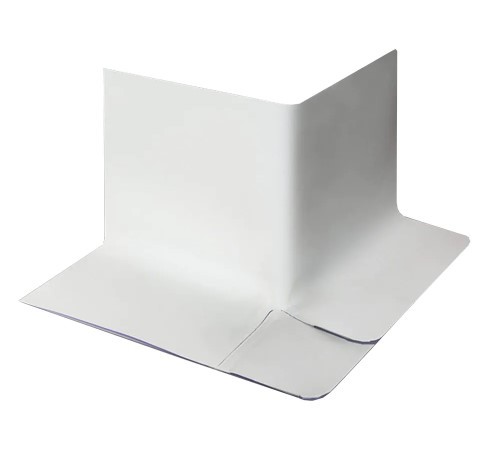
Pre-formed Edges and Transitions
Walls and risers are wrapped with the same snug-fitting membrane and then welded(TPO, PVC) or adhered(EPDM) to the rest of the covering.
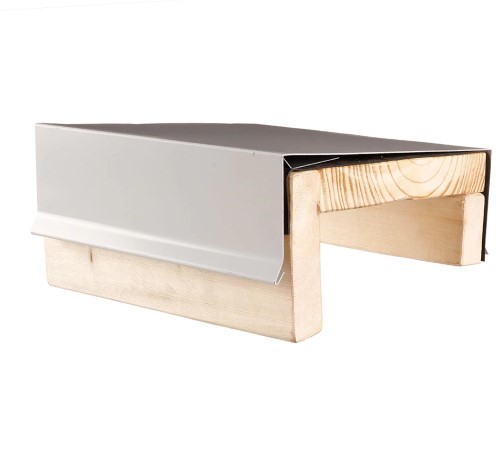
Cap Flashings
Membrane material is extended up the building’s parapet walls and then capped with strong metal covers to stop water from getting under the roof.
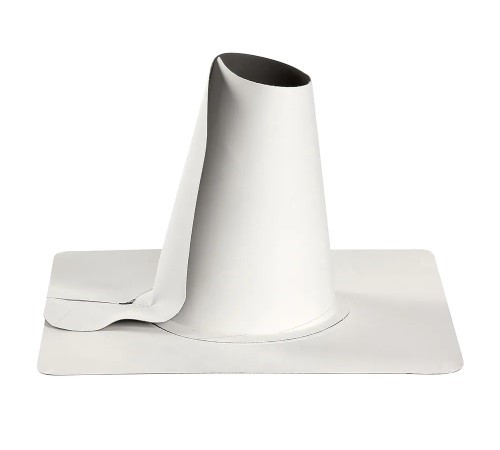
Vent and Pipe Flashings
Accessory flashings are flexible, allowing the actual roof material to directly seal these leak sources rather than through a secondary gasket or caulking.Â

